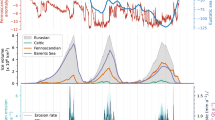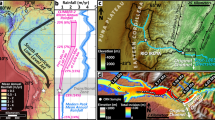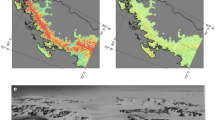Abstract
Since the Last Glacial Maximum, the extent of glaciers in many mountainous regions has declined, and erosion driven by glacial processes has been supplanted by fluvial incision and mass wasting processes. This shift in the drivers of erosion is thought to have altered the rate and pattern of denudation of these landscapes. The Washington Cascades Mountains in the northwestern USA still bear the topographic imprint of Pleistocene glaciations, and are affected by large variations in precipitation, making them an ideal setting to assess the relative controls of denudation. Here we show that denudation rates over the past millennia, as determined by 10Be exposure ages, range from 0.08 to 0.57 mm yr−1, about four times higher than the rates inferred for million-year timescales. We find that the millennial timescale denudation rates increase linearly with modern precipitation rates. Based on our landscape analyses, we suggest that this relationship arises because intense precipitation triggers landslides, particularly on slopes that have been steepened by glacial erosion before or during the Last Glacial Maximum. We conclude that the high modern interglacial denudation rates we observe in the Washington Cascades are driven by a disequilibrium between the inherited topography and the current spatial distribution of erosional processes that makes this range particularly sensitive to spatial variations in climate.
This is a preview of subscription content, access via your institution
Access options
Subscribe to this journal
Receive 12 print issues and online access
$259.00 per year
only $21.58 per issue
Buy this article
- Purchase on Springer Link
- Instant access to full article PDF
Prices may be subject to local taxes which are calculated during checkout



Similar content being viewed by others
References
Porter, S. C. Pleistocene glaciation in the southern part of the North Cascade Range, Washington. Geol. Soc. Am. Bull. 87, 61–75 (1976).
Mitchell, S. G. & Montgomery, D. R. Influence of a glacial buzzsaw on the height and morphology of the Cascade Range in central Washington State, USA. Quat. Res. 65, 96–107 (2006).
Norton, K. P., Abbühl, L. M. & Schlunegger, F. Glacial conditioning as an erosional driving force in the Central Alps. Geology 38, 655–658 (2010).
Doten, C. O., Bowling, L. C., Lanini, J. S., Maurer, E. P. & Lettenmaier, D. P. A spatially distributed model for the dynamic prediction of sediment erosion and transport in mountainous forested watersheds. Water Resour. Res. 42, W04417 (2006).
Ballantyne, C. K. Paraglacial geomorphology. Quat. Sci. Rev. 21, 1935–2017 (2002).
PRISM, United States Average Monthly or Annual Precipitation 1971–2000 (Oregon State Univ., 2006).
Smiley, C. J. The Ellensburg Flora of Washington Vol. 35 (Univ. of California Publications in Geological Sciences, 1963).
Leopold, E. B. & Denton, M. F. Comparative age of grassland and steppe east and west of the northern rocky mountain. Ann. Missouri Bot. Garden 74, 841–867 (1987).
Takeuchi, A. & Larson, P. B. Oxygen isotope evidence for the late Cenozoic development of an orographic rain shadow in eastern Washington, USA. Geology 33, 313–316 (2005).
Hunting, M. T., Bennett, W. A., Livingston, V. E. Jr & Moen, W. S. Geologic Map of Washington. (Washington Division of Mines and Geology, 1961).
Brocklehurst, S. H. & Whipple, K. X. Response of glacial landscapes to spatial variations in rock uplift rate. J. Geophys. Res. 112, F02035 (2007).
DiBiase, R. A., Whipple, K. X., Heimsath, A. M. & Ouimet, W. B. Landscape form and millennial erosion rates in the San Gabriel Mountains, CA. Earth Planet. Sci. Lett. 289, 134–144 (2010).
Safran, E. B. et al. Erosion rates driven by channel network incision in the Bolivian Andes. Earth Surf. Process. Landf. 30, 1007–1024 (2005).
Ouimet, W. B., Whipple, K. X. & Granger, D. E. Beyond threshold hillslopes: Channel adjustment to base-level fall in tectonically active mountain ranges. Geology 37, 579–582 (2009).
Ahnert, F. Functional relationships between denudation, relief, and uplift in large, mid-latitude drainage basins. Am. J. Sci. 268, 243–263 (1970).
Reiners, P. W., Ehlers, T. A., Mitchell, S. G. & Montgomery, D. R. Coupled spatial variations in precipitation and long-term erosion rates across the Washington Cascades. Nature 426, 645–647 (2003).
Parker, G. & Perg, L. A. Probabilistic formulation of conservation of cosmogenic nuclides: Effect of surface elevation fluctuations on approach to steady state. Earth Surf. Process. Landf. 30, 1127–1144 (2005).
Wittmann, H., von Blanckenburg, F., Kruesmann, T., Norton, K. P. & Kubik, P. W. Relation between rock uplift and denudation from cosmogenic nuclides in river sediment in the Central Alps of Switzerland. J. Geophys. Res. 112, F04010 (2007).
Molnar, P. The state of interactions among tectonics, erosion, and climate: A polemic. GSA Today 19, 44–45 (2009).
Stock, G. M. et al. Spatial and temporal variations in denudation of the Wasatch Mountains, Utah, USA. Lithosphere 1, 34–40 (2009).
Shuster, D. L., Ehlers, T. A., Rusmoren, M. E. & Farley, K. A. Rapid glacial erosion at 1.8 Myr revealed by 4He/3He thermochronometry. Science 310, 1668–1670 (2005).
Haug, G. H. et al. North Pacific seasonality and the glaciation of North America 2.7 million years ago. Nature 433, 821–825 (2005).
Stock, J. D. & Dietrich, W. E. Erosion of steepland valleys by debris flows. Geol. Soc. Am. Bull. 118, 1125–1148 (2006).
Whipple, K. X. & Tucker, G. E. Dynamics of the stream-power river incision model: Implications for height limits of mountain ranges, landscape response timescales, and research needs. J. Geophys. Res. 104, 17661–17674 (1999).
Montgomery, D. R. & Dietrich, W. E. A physically based model for the topographic control on shallow landsliding. Water Resour. Res. 30, 1153–1171 (1994).
Riebe, C. S., Kirchner, J. W., Granger, D. E. & Finkel, R. C. Minimal climatic control on erosion rates in the Sierra Nevada, California. Geology 29, 447–450 (2001).
von Blanckenburg, F. The control mechanisms of erosion and weathering at basin scale from cosmogenic nuclides in river sediment. Earth Planet. Sci. Lett. 237, 462–479 (2005).
Willett, S. D. & Brandon, M. T. On steady states in mountain belts. Geology 30, 175–178 (2002).
Hack, J. T. Interpretation of erosional topography in humid temperate regions. Am. J. Sci., Bradley Volume 258-A, 80–97 (1960).
Riebe, C. S., Kirchner, J. W., Granger, D. E. & Finkel, R. C. Erosional equilibrium and disequilibrium in the Sierra Nevada, inferred from cosmogenic 26Al and 10Be in alluvial sediment. Geology 28, 803–806 (2000).
Norton, K. P., von Blanckenburg, F. & Kubik, P. W. Cosmogenic nuclide-derived rates of diffusive and episodic erosion in the glacially sculpted upper Rhone Valley, Swiss Alps. Earth Surf. Process. Landf. 35, 651–662 (2010).
Niemi, N. A., Oskin, M., Burbank, D. W., Heimsath, A. M. & Gabet, E. J. Effects of bedrock landslides on cosmogenically determined erosion rates. Earth Planet. Sci. Lett. 237, 480–498 (2005).
Balco, G., Stone, J. O., Lifton, N. A. & Dunai, T. J. A complete and easily accessible means of calculating surface exposure ages or erosion rates from 10Be and 26Al measurements. Quat. Geochronol. 3, 174–195 (2008).
Acknowledgements
S.M. acknowledges the support of the Stanford Graduate Fellowship and G.E.H. acknowledges the support of the Terman Fellowship. We thank T. A. Ehlers, S. D. Willet, P. W. Reiners, and K. X. Whipple for thoughtful comments.
Author information
Authors and Affiliations
Contributions
S.M. designed and performed experiments, analysed data, and wrote the paper; G. E. H. and C. P. C. designed and performed experiments, and wrote the paper; K.B. and D.H.R. analysed data; and N.L. performed experiments.
Corresponding author
Ethics declarations
Competing interests
The authors declare no competing financial interests.
Supplementary information
Supplementary Information
Supplementary Information (PDF 641 kb)
Rights and permissions
About this article
Cite this article
Moon, S., Page Chamberlain, C., Blisniuk, K. et al. Climatic control of denudation in the deglaciated landscape of the Washington Cascades. Nature Geosci 4, 469–473 (2011). https://doi.org/10.1038/ngeo1159
Received:
Accepted:
Published:
Issue Date:
DOI: https://doi.org/10.1038/ngeo1159
This article is cited by
-
Landslide susceptibility modeling by interpretable neural network
Communications Earth & Environment (2023)
-
Tree Mortality may Drive Landscape Formation: Comparative Study from Ten Temperate Forests
Ecosystems (2023)
-
Warming-driven erosion and sediment transport in cold regions
Nature Reviews Earth & Environment (2022)
-
Topographic stress control on bedrock landslide size
Nature Geoscience (2021)
-
Topographic controls on the annual runoff coefficient and implications for landscape evolution across semiarid Qilian Mountains, NE Tibetan Plateau
Journal of Mountain Science (2020)



